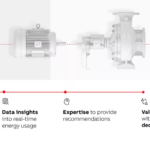
The idea of upgrading hundreds of motors with more efficient models is daunting. Fortunately, data and expertise can reveal the way forward As industry strives towards net zero targets, business leaders are now also contending with rising energy costs. Energy efficiency addresses both of these concerns while maintaining the same output. It’s no surprise that in a recent global energy efficiency survey of 2,294 industrial companies commissioned by ABB, an overwhelming majority of industry leaders (97 per cent) reported that they are already investing or plan to invest in improving energy efficiency. They cited cost savings as the most important reason for investing, closely followed by corporate sustainability commitments. Around 70 per cent of electricity consumed by industry is converted into motion by electric motor-driven systems, according to the International Energy Agency. There is plenty of scope for energy savings. Many existing systems either do not meet the latest efficiency standards or are over-dimensioned and consume more power than required. As a result, switching these systems to more efficient modern alternatives is one of the most cost-effective and impactful ways to reduce energy consumption and the associated emissions. Of the companies investing in energy efficiency, almost two-thirds (65 per cent) intend to upgrade their equipment to best-in-class efficiency ratings, such as installing high-efficiency motors and variable speed drives (VSDs). However, this is easier said than done. Industrial businesses with hundreds of pumps, fans, conveyors and other moving equipment rely on electrical powertrains. These are made up of motors, as well as VSDs, which save energy by controlling motor speed. Identifying the best energy-saving opportunities comes down to gathering accurate data and analysis by someone with expert knowledge. This will enable businesses to target their investments to maximise efficiency gains and reduce energy consumption, carbon emissions and waste. The traditional approach to gathering data has limitations. Energy efficiency appraisals are a well-established tactic that 51 per cent of survey respondents are planning to use. Until now, energy appraisals have required a specialist to visit the site for manual data-gathering and review. With this approach, it’s only possible to focus on a few of the largest motor-driven systems as an appraisal requires time-consuming effort, making it attractive only for the individual applications that offer high potential for energy savings. With this traditional method, the energy-saving potential of smaller, inaccessible or less obvious targets for energy efficiency savings is overlooked. Together, those smaller powertrains represent a huge untapped opportunity. Today, advances in digital technologies allow smarter asset health management for rotating equipment and electrical powertrains. Using the same data in combination with know-how on electrical powertrains and applications easily enables the identification of energy-saving potential. Plug-and-play condition monitoring solutions mean that it’s now possible to gain insight into the operation of any electrical powertrain without a major investment of time. Analysing this data will identify the energy-saving potential for every motor individually, as well as the fleet as a whole. This will enable industrial businesses to prioritise investment by calculating the potential for each motor and the payback on the investment required to upgrade to high-efficiency motor-driven systems. This combined approach is already achieving results for some operators, such as Waggeryd Cell, a pulp mill in southern Sweden. Although the facility already had industry-leading energy efficiency, it wanted to do even more. The plant manager commissioned an energy efficiency appraisal based on measured operational data to identify motor-driven systems with potential for energy saving. This enabled Waggeryd Cell to identify the 10 motor-driven systems that stood to benefit most from upgrading to more efficient units. With a focus on a fast return on investment, the business prioritised the replacement of six of these to further reduce the site’s energy consumption and emissions. A digital energy efficiency appraisal can boost energy savings even for relatively new facilities. With recent advances in electric motor design, even motors installed as recently as five years ago may still benefit from upgrading. There is also huge potential to identify motors without VSDs and running at a fixed speed could unlock further energy savings. It’s estimated that only 23 per cent of the world’s industrial motors are presently equipped with a drive and operate at variable speed, whereas most would benefit from one. Pairing a VSD with an existing pump, fan or compressor motor can easily reduce power consumption by more than 25 per cent. The key to finding these opportunities is the use of digital solutions that provide access to data that shows how efficient electrical powertrains are operated. With ABB’s new energy appraisals, the industry can now identify and prioritise energy savings at a scale never possible before. Learn more about ABB and the role digitalisation is playing in achieving net zero. By Adrian Guggisberg, President, ABB Motion Services


